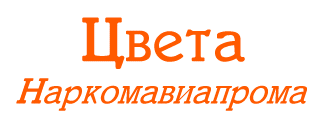
The NKAP Templates Explained
Part 2
Bomber Aviation
In addition to the fighter
and Assualt aviation templates, the NKAP also designed two different templates
for use with Attack Bombers, such as the Pe-2 (and later the Tu-2). These
templates were not to apply to Medium or Long-Range bombers, and seperate
templates were issued for machines like the Il-4 and Pe-8 (discussed in
a later section). As well, the last minute 1944 recommendation for the
use of a two-color grey/grey scheme as on Fighter Aviation also included
this class of aircraft, but again, as before on other non-fighter programmes,
no such camouflage was ever known to have been used.
The Attack Bomber template
was issued in two variants, and these appear not to have been distributed
at the same time. It seems that Variant #2 was issued a bit later than
#1, and perhaps was the result of some re-thinking on the part of Narkomaviaprom.
Variant #1 was intended for the use of AMT lacquers -4/-12/-1, and looked
rather odd and complicated.
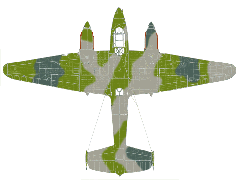
One can imagine that the Factories' reaction to
this scheme was less than scintillating. In the first case, painting the
spinners different colors and keeping track of them for each side would
have been irritating, as would the complexity of the pattern as it wrapped
over the fuselage. Also, the use of the AMT-12 color seems to have been
an afterthought, as if the NKAP designer forgot to use it and drew some
on at the last moment. In all of the Pe-2 photos that I have seen over
the years, none of them strike me as having been painted in this way. I
suspect strongly that this template was seldom used, if at all.
The second Variant of this template again was developed
with the use of AMT lacquers -4/-12/-1 in mind, but later on it seems that
the provision was included to use other paints, notably Ax-m metal lacquers.


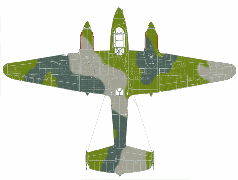
This pattern was much more in line with the other
NKAP template work, and represented a much better scheme from the point
of view of the Factories. This application is certainly known on numerous
Pe-2s, and seems to have been in use right through 1945. It is also interesting
to note that this same pattern might have been executed with AII lacquers
(probably Green, Light Brown, and Brown), as well. A number of NKAP Var.#2
schemes of this type wear colors that are very incongruous with the appearance
of AMT, but in line with AII; noting that the Pe-2 programme utilized large
quantities of AII lacquer right through to the Post War period, it seems
very plausible that this was in fact done. As well, several permutations
of this arrangement are known in AII colors on the Pe-2, and one has to
think here that this template again was the source of inspiration for these.
The appearance of the Pe-2 in Ax-m metal lacquers
is most interesting, as well. These colors are all quite dark, and the
resulting contrast within the scheme is very low indeed.
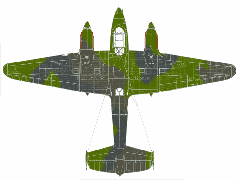
This effect is all the more pronounced in black-and-white
photography [you can replicate this to a degree by viewing this image in
Greyscale], where the colors are often completely indistinguishable. I
have the suspicion that this is in fact the reason why we see so many late
War Pe-2s drawn in various artwork in single color green schemes. I would
contend, rather, that most of these are very probably Ax-m lacquer camouflage
applications.
The Variant #2 template was thought to have been
used on the Tu-2 programme, as well, and certainly there are many examples
of this aircraft that seem to be wearing versions of this scheme. Alas,
the full story of the development and implementation of coloration on the
Tu-2 programme remains largely unknown.
U-2/Po-2
The venerable kurkurznik
('corn-stalk cutter') was not exempt from the design intentions of the
NKAP during the Great Patriotic War. During 1943 an NKAP template was issued
for this extraordinarily useful machine, and was intended for use on the
military versions of the aircraft, only. The template lists the AMT colors
-4/-12/-1 again, and but really offers little else in elaboration.
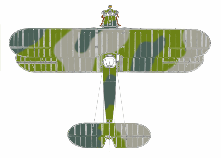
The number of photographs of U-2s (Po-2s) in various
collections dating from the GPW are certainly in the thousands. And the
permutations of odd, strange, curious, brilliant, absurd, indifferent,
and remarkable camouflage applications shown therein are beyond any count.
But in all of that, one simply does not run across any U-2 that I can recall
which features this pattern. Indeed, one rarely encounters a U-2 that is
possibly covered in AMT lacquers of any kind.
With so many known examples, why do we not see this
one? I suspect that the answer is very logical, in fact. AII aviation aerolacquers
were developed during the 1930's specifically to cover fabric surfaces.
Indeed, this is precisely why the NKAP recommended the use of AII Aluminum
as a primer for fabric surfaces later on. Noting that the U-2 is entirely
fabric covered, it seems altogether possible that AMT lacquers were never
used by the Factories making the workman-like biplane because these would
have given inferior results to AII. It is certainly true that there are
no described AMT camouflage applications from the Factories for the U-2;
perhaps this is the explanation why.
As well, there was certainly no need for additional
camouflage patterns on this programme. The number of Factory applied schemes
on the U-2 is astounding, and one cannot see where any of these Factories
would have needed to increase their already burgeoning repertoires of applications.
With AII possibly in exclusive use, and no need for additional scheme ideas,
it seems very possible that the manufacturers of the U-2 simply ignored
the NKAP templates altogether (as, by the way, they were certainly entitled
to do).







